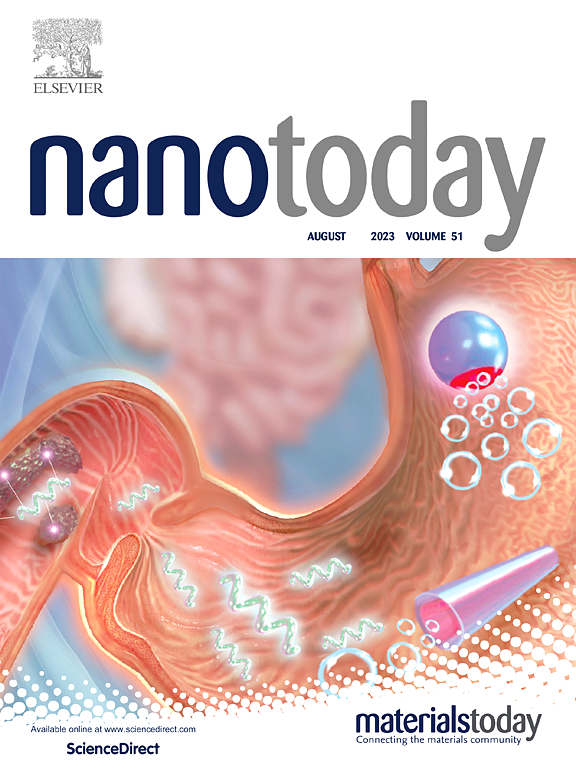Overcoming the p-EMT-mediated stromal barrier at the tumor periphery with hybrid membrane-camouflaged nanoplatform for enhanced chemotherapy
IF 10.9
1区 材料科学
Q1 CHEMISTRY, MULTIDISCIPLINARY
引用次数: 0
Abstract
Effective intratumoral penetration of nanotherapeutics is the prerequisite for successful cancer treatment. However, the dense tumor stroma often hinders deep drug penetration. In this work, we identified a previously overlooked physiological barrier at the leading edge of tumor nests, which was formed by the tumor cells undergoing partial epithelial-mesenchymal transformation (p-EMT). Adjacent cancer-associated fibroblasts (CAFs) promote this process through paracrine signaling, ultimately blocking nanoparticle penetration into the tumor interstitium. In light of this, we elaborately developed a tailored nanodrug, C/D-MOFHM, by camouflaging a curcumin (CUR)-based, doxorubicin (DOX)-loaded, metal-organic framework nanoparticle with a hybrid membrane derived from CAFs and tumor cells. The C/D-MOFHM selectively deliveres CUR to CAFs to inhibit the secretion of p-EMT-inducing factors (e.g., TGF-β1 and IL-6), thereby suppressing p-EMT-mediated stromal matrix formation at the tumor periphery. As a result, augmented drug penetration of C/D-MOFHM is evidently observed, leading to potent tumor growth inhibition and metastasis suppression. This p-EMT blockade strategy for diminishing the stromal barrier at tumor margins represents a feasible approach to improve drug penetration into solid tumors for enhanced tumor therapy.
利用混合膜伪装纳米平台克服肿瘤周围p- emt介导的间质屏障,增强化疗
纳米治疗药物在肿瘤内的有效渗透是成功治疗癌症的先决条件。然而,致密的肿瘤间质往往阻碍药物深入渗透。在这项工作中,我们在肿瘤巢的前沿发现了一个以前被忽视的生理屏障,这是由肿瘤细胞经历部分上皮-间质转化(p-EMT)形成的。邻近的癌症相关成纤维细胞(CAFs)通过旁分泌信号传导促进这一过程,最终阻止纳米颗粒渗透到肿瘤间质。鉴于此,我们精心开发了一种定制的纳米药物,C/D-MOFHM,通过将姜黄素(CUR)为基础,多柔比星(DOX)为负载,金属有机框架纳米颗粒伪装成来自CAFs和肿瘤细胞的杂交膜。C/D-MOFHM选择性地将CUR递送至CAFs,抑制p- emt诱导因子(如TGF-β1和IL-6)的分泌,从而抑制p- emt介导的肿瘤周围间质基质的形成。因此,C/D-MOFHM明显增强了药物渗透,从而有效抑制肿瘤生长和转移。这种p-EMT阻断策略可以减少肿瘤边缘的间质屏障,这是一种可行的方法,可以提高药物对实体瘤的渗透,从而增强肿瘤治疗。
本文章由计算机程序翻译,如有差异,请以英文原文为准。
求助全文
约1分钟内获得全文
求助全文
来源期刊

Nano Today
工程技术-材料科学:综合
CiteScore
21.50
自引率
3.40%
发文量
305
审稿时长
40 days
期刊介绍:
Nano Today is a journal dedicated to publishing influential and innovative work in the field of nanoscience and technology. It covers a wide range of subject areas including biomaterials, materials chemistry, materials science, chemistry, bioengineering, biochemistry, genetics and molecular biology, engineering, and nanotechnology. The journal considers articles that inform readers about the latest research, breakthroughs, and topical issues in these fields. It provides comprehensive coverage through a mixture of peer-reviewed articles, research news, and information on key developments. Nano Today is abstracted and indexed in Science Citation Index, Ei Compendex, Embase, Scopus, and INSPEC.
 求助内容:
求助内容: 应助结果提醒方式:
应助结果提醒方式:


